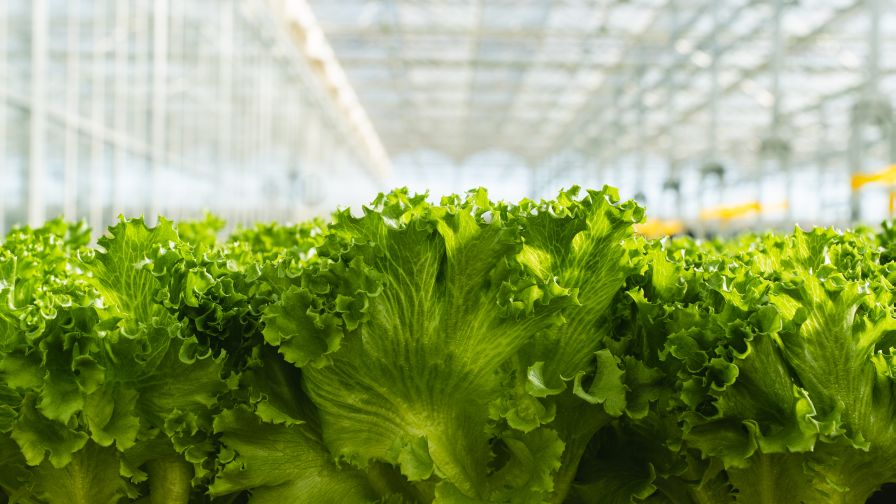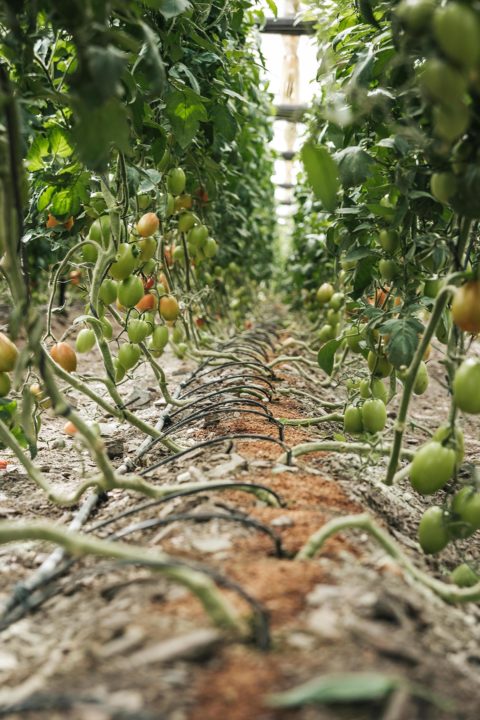Growers Gaining Market Share in Leafy Greens

This crispy green leaf lettuce is grown at Gotham Greens. Photo: Gotham Greens
The leafy greens market ebbs and flows with the weather, says Brian Cook, President of Local Bounti. Due to heavy rains in California’s Salinas Valley in March, there may be a reduced supply of leafy greens.
“We wish the best to the folks out there fighting the good fight,” Cook says. “But it looks like they will be missing some planting in the Salinas area. We will probably see a reduced amount of availability out there in traditionally-farmed lettuce.”
Cook says one benefit of growing in a controlled environment is the surety of the supply chain. Local Bounti is always seeking more shelf space at grocery stores, but as a hydroponic leafy greens grower, it can also help fill in the gap when there are unexpected weather conditions.
While there has not been a significant impact on prices yet, the adverse weather that California has faced will likely affect pricing in 2023, says Viraj Puri, CEO and Co-founder of Gotham Greens.
“This situation demonstrates some of the benefits of indoor farming,” Puri says. “Not only does it help provide a cleaner, more controlled environment, but it also allows greenhouse growers to provide the market with more consistent product attributes, quality, and supply, all of which are inherently less predictable with conventional farming.”
Puri says the leafy greens market continues to grow as consumers incorporate more fruits and vegetables into their diets. The leafy greens market is growing across various sectors, including conventional, organic, and greenhouse-grown, Puri says.
Research Underway For CEA Seeds
Unfold, a leading seed development company, is focusing its efforts on breeding leafy greens varieties best suited for CEA. Chief Strategy Officer (and former CEO) John Purcell says Unfold has a license to Bayer’s germplasm for vertical farming, but Bayer reserves the right to customize its germplasm for greenhouse, glasshouse, and open field production.
“We’re really trying to select for varieties that perform best in a completely controlled environment under defined temperature, humidity, and lighting conditions,” Purcell says of Unfold’s research in CEA seeds. “We’re looking for new varieties that will excel in those conditions, meet production needs, like yields, to be competitive, but also have that quality from a sensory perspective at the consumer level.”
Purcell says Unfold launched an Innovation Partner Program (IPP) to move from a transactional approach as a seed company to a collaborative relationship with producers. Through its IPP, Unfold has publicly announced three partnerships: GoodLeaf Farms in Canada, Bowery Farming in the U.S., and Sustenir in Singapore.
When breeding for CEA, Purcell says that Unfold works to select a seed variety that is profitable for growers and appealing to consumers.
“It has to work at the grower level — they have to be able to produce it economically and turn a profit. The crops must have the right yields; the growers must be able to control the input costs; and there has to be enough vigor in those plants to allow growers to grow them successfully,” Purcell says. “But, it also has to be something that grocers want to stock and consumers want to buy. For us, that’s what it’s all about — making sure that we develop seed varieties that perform well agronomically while making sure the seeds produce crops that meet the needs of the consumer.”
In the last few years, Unfold researchers used phenotypic selection and molecular breeding to determine if a crop variety had the performance and traits of interest under a specific condition. Unfold also moved to predictive breeding, which uses modeling to determine what combinations of characteristics in a crop variety will be most beneficial. Predictive breeding can be done on a computer, reducing the need to test in a lab or field.
Unfold’s research is geared toward making plants easier to grow and more resilient. In vertical farming, growers are looking to reduce their cost of goods.
“One key feature, for example, is the time to harvest and how quickly a crop matures. Our research also aims at finding ways to make sure varieties develop uniformly so crops mature at the same time,” Purcell says. “We’re working on anything we can do to improve the conversion of inputs like nutrition, water, and lighting to convert that to biomass of the plant being harvested for the consumer.”
The relationship between Local Bounti and its seed suppliers is a partnership. The suppliers provide seeds, but Local Bounti provides a trialing facility because it has three different types of growing systems — deep water culture (ponds/pools), gutters, and channels, and grows both organic and conventional.
“We have a variety of different growing systems, which allows seed suppliers to do tests on a production scale. They work with us to see how the seeds react in three different types of environments,” Cook says. “We are good partners with them, as well. That win-win factor ensures that we get seeds when we need them.”
Cook says existing seed companies are expanding their reach to include more varieties bred for CEA, and new companies are entering this market.
“If the industry shows it’s going in a different direction, I haven’t seen any one vendor of ours say, ‘We’re going to keep doing what we’ve been doing,’” Cook says. “Whether they’re putting their toes in the water or jumping into the deep end, that varies across the different seed suppliers out there. We are seeing some new seed suppliers popping up that are trying to build a name for themselves specifically within the controlled-environment category.”
Flavorful Varieties Are Closer to Home
A major benefit of CEA when growing leafy greens is the transportation time, Cook says. Consumption is taking place closer to greenhouses than outdoor farms, so the time to market shrinks significantly. For leafy greens grown in a CEA facility, the product can be transported to a distribution center and reach its retail destination within a few hours of harvesting.
“CEA allows selecting production cultivars for flavor,” Cook says. “Shelf life and time on the road were the more important things to solve for with outdoor ag, so you lost flavor because the seed variety was built specifically for transit time. We’re able to prioritize taste and texture.”
Purcell says that CEA reduces the duration of time between harvesting the crop and delivering it to consumers.
“What you see with CEA is that greenhouse operations and vertical farms are closer to urban areas,” he says. “You can now get within a day or two from the production to the end market, especially if you package and brand it yourself.”
Puri of Gotham Greens says 98% of leafy greens grown in the U.S. come from California and Arizona. The resources required to transport the product across the country are high, especially with rising fuel costs.
“We’re continuing to grow our brand footprint nationally through our regional network of greenhouses across America in order to reach our goal of delivering Gotham Greens fresh produce within a day’s drive from our greenhouses to 90% of consumers across the U.S.,” Puri says. “This local cultivation and regional distribution model helps us deliver our products quickly after being harvested to ensure they are fresh tasting, nutritionally dense, and long-lasting.”
Many growers are expanding to hold a larger share of the CEA leafy greens market. As more acres of production space come online every year, growers are competing for market share, revenue, and unique flavors to please a crowd. Growers expect that the future is bright for indoor-grown leafy greens, due to the proximity to urban areas,
flavorful varieties, and more.










